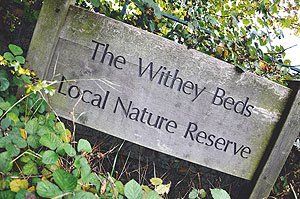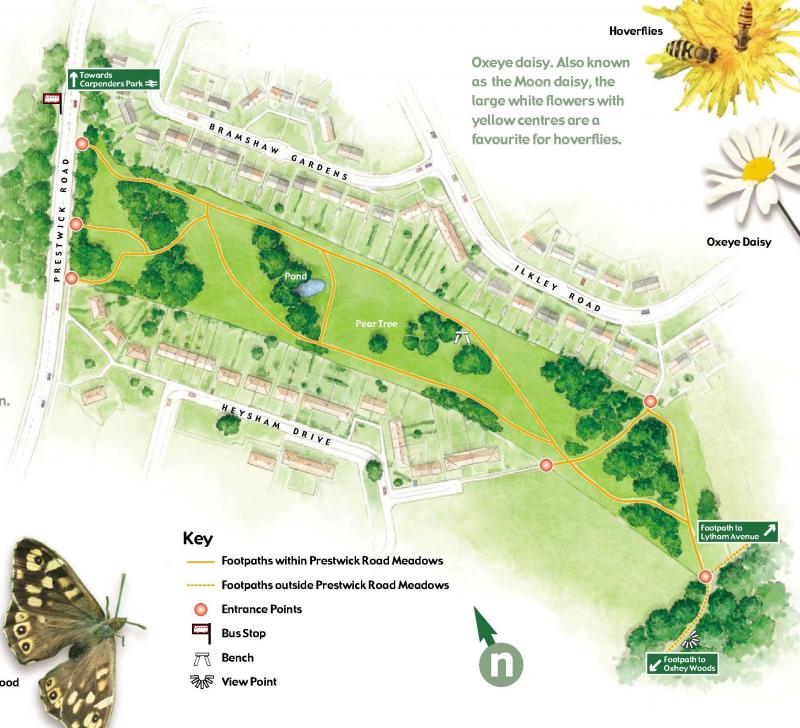LOCAL NATURE RESERVES
-
LOCAL NATURE RESERVES
Button
THE IMPORTANCE OF NATURE RESERVES
Throughout the 20th century wetlands have greatly declined within the district, as well as on a national scale. A drier county, changes in land use and urban development have all contributed to this. As such The Withey Beds Local Nature
Reserve (LNR) is one of the few remaining wetlands in Hertfordshire.
The LNR also offers a variety of habitats and supports some fascinating plants and animals, particularly birds and insects which are characteristic of swamp and fen. For example, four
invertebrates which are of a high national importance have all been found at The Withey Beds LNR. These are the oak jewel beetle, a soldier fly, a solitary bee and Roesel’s bush cricket.
The diversity of habitats include wet woodland, mature standard trees, swamp, marsh, drier grassland, standing and fallen dead wood, open ditches and the River Colne. It is this
diversity which provides an ideal habitat for many species.
The River Colne and its floodplain provide resources which have attracted people for thousands of years. Situated within a designated Area of Archaeological Significance The Withey
Beds LNR is adjacent to a string of major sites of prehistoric, Roman and Medieval date; including the nationally important 'Manor of the Moor'.
CROXLEY COMMON MOOR
Whilst all around has been built on or improved for modern agriculture, Croxley Common Moor remains little changed - a wonderful untouched haven for wildlife close to Watford in Croxley Green, just 100 yards from Croxley station on the Metropolitan line of the London Underground. Pedestrian access is either via Mill Lane in Croxley Green, or from Moor Lane Crossing which lies just off Tolpits Lane. Please note that there is no designated car park for Croxley Common Moor, but local parking is available within Croxley.
Its 100 acres of historic grassland straddle the flood plain of the River Gade. It is the action of the river scouring across the plain, combined with centuries of grazing, which has produced the rich and diverse plant life that can be seen today. Common Moor covers 41.9 hectares and has been designated as a Site of Special Scientific Interest as well as a Local Nature Reserve due to the special plantlife and community value.
The moor has over 250 different types of plants in addition to numerous ant hills made by yellow meadow ants and form a series of mounds across the Local Nature Reserve. These ants make a tasty meal for green woodpeckers which can often be heard 'yaffling' in the background.
During the winter volunteers remove unwanted vegetation that would otherwise turn the open moor into woodland and from around April each year they are helped by a number of cows which lazily graze the moor.
Join the Friends of Croxley Common Moor. Everyone is welcome and no experience is necessary.
WITHEY BEDS
The Withey Beds is a Local Nature Reserve located close to Rickmansworth and Moor Park, with its main entrance on Moor Lane (A4145). There is no dedicated parking for the reserve, but it is often possible to park on Moor Lane in the layby opposite the entrance. The Withey Beds reserve is a 15-20 minute walk from Moor Park tube station.
The Withey Beds are one of the few remaining wetlands in Hertfordshire, offering a variety of habitats and supporting some fascinating plants and animals including birds and insects characteristic of swamp and fen.
‘Withey bed’ is an old English term used to describe the growing of different species of willow for coppicing. They once formed an important part of the local village economy; supplying poles for
basketwork, thatching, firewood and many other uses. The withey beds in Rickmansworth were traditionally coppiced to provide such products and this form of management resulted in
the varied habitats becoming established.
Today, The Withey Beds is still managed using traditional techniques. The rotational coppicing of willow helps preserve the character of the site and grazing with cattle, or cutting and removing the vegetation within the field, will help halt encroaching scrub as well as preserve the character of this special site and allow wildlife to continue to flourish.
The diversity of habitats in The Withey Beds include wet woodland, mature standard trees, swamp, marsh, drier grassland, standing and fallen dead wood, open ditches, and the River Colne. It is this diversity which provides an ideal breeding ground for migratory birds and other species, including many rare insects.
As part of the management of the site, a number of bird boxes are set up around the site, including those for woodpeckers, tits, robins and barn owls. In addition, a hibernaculum for bats has been established, where they hibernate during the winter months; some may even use it as a summer roost.
Please contact the Friends of The Withey Beds if you would like to get more involved in this great open space.
PRESTWICK MEADOWS
Prestwick Road Meadows Local Nature Reserve is a remnant of old farm meadows in South Oxhey. The ancient hedgerows that separated the fields can still be seen today.
More than 97% of flower rich hay meadows and pastures have been lost since the 1940s and this is one of the few meadows that has survived untouched.
Summer is the best time to see Prestwick Road Meadow in flower, although the seasonal pond can be a hive of activity with tadpoles, frogs, herons, butterflies and dragonflies.
Three Rivers District Council
Three Rivers House
Northway
Rickmansworth
Herts WD3 1RL
Tel: 01923 776611
Email: leisure@threerivers.gov.uk




